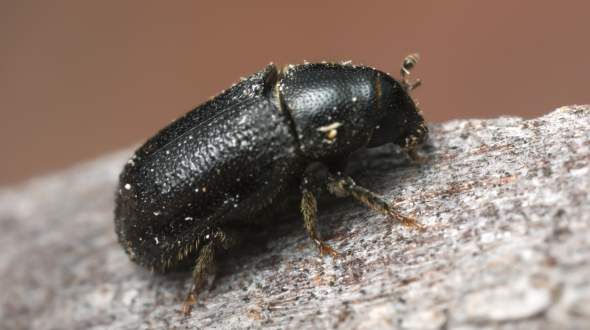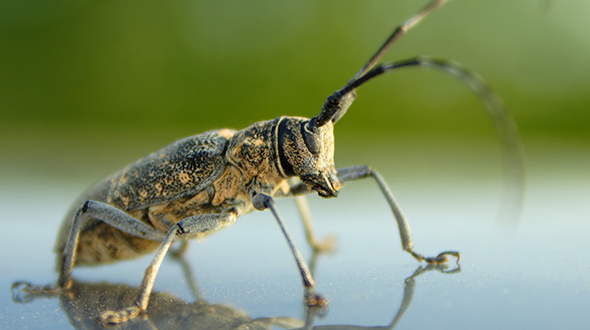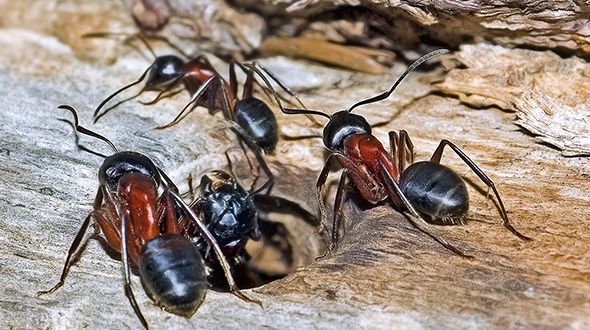
Prevent your trees from rapid decline and death when wood-boring insects attack. Knowing how to control wood-boring insects will help you keep your Marietta, Georgia, trees healthy and thriving.
toddsmariettatreeservices.com gathered wood-boring insect species, identification, and control information to help you keep your Marietta, Georgia, trees safe.
Wood-Boring Insects
Wood-boring insects include a range of arthropods that cause damage to trees and wooden structures. This group of insects features an array of insect species at different life cycle stages (from larvae to adults). Wood-boring insects are seen as pests due to the potentially severe damage they cause in urban and rural areas.
Wood-Boring Insect Control

Systemic insecticides applied via trunk injection, bark sprays, or as a soil drench are effective against flathead borers and may be the only practical method for treating tall trees. Popular systemic insecticides include:
- Bonide Systemic Granules
- Mighty Mint Insect and Pest Control
- Natria Neem Oil Spray
Tip: Apply a systemic insecticide for trees when it is in the growing season.
Contact pesticides control wood-boring insects when they come in direct contact with the pest. Systemic insecticides are absorbed by and transported through plant tissue. Such products can render some or all of a plant toxic to insects that feed on it. Some common contact insecticides are:
- Pyrethroids (bifenthrin and permethrin)
- Chlorantraniliprole
- Imidacloprid
- Dinotefuran
- Emamectin benzoate
- Azadirachtin
Note: Each state has its own standards regarding pesticide use. Make sure you can legally use a pesticide before applying it to your tree(s).
Tip: Hire a professional tree service to treat your trees and alert regional representatives of any potential widespread infestations.
Wood-Boring Insect Species
Wood or tree borers could be bark beetles, twig pruners, or flat-headed borers, among other species. All boring insects are a hazard to a tree’s health, surrounding structures, and people. Consider the following species information:
1. Bark Beetles (Scolytinae)

Bark beetles tunnel under tree bark, cutting off its supply of food and water needed to survive. Bark beetles can kill a mature tree in two to four weeks during warmer months.
Identification – Bark beetle adults are tiny, cylindrical, hard-bodied insects about the size of a rice grain.
Tree Damage – Some trees slowly fade in color from green to brown, while others may die within a few weeks of infestation (these trees may not show signs of chlorosis, fading, or decline for several months.
Control Method(s) – If trees are infested, prune and dispose of bark beetle-infested limbs. If the tree’s trunk is extensively infested, the entire tree should be removed.
Note: The only effective treatment for bark beetles is preventative.
Vulnerable Tree Species: Bark beetles are attracted to tree species that are stressed, diseased, or injured.
2. Twig and Branch Pruners (Elaphidionoides and Agrilus species)

This insect is considered a secondary invader of trees in decline. The twig pruner attacks healthy twigs and small branches (the female lays an egg in the bark, and when the eggs hatch, the legless grubs bore into the twig). Mature larvae chew concentric cuts outward in the white wood without chewing through the bark. The infested branch eventually drops to the ground with the larva inside.
Identification – The twig pruner is a slender grayish-yellow, long-horned beetle about 1/2 inch long.
Tree Damage – Twig and branch pruner larvae feed beneath the bark, girdling twigs and branches.
Control Method(s) – Pick up and destroy any detached twigs. The insect’s life cycle is completed inside these fallen twigs. Eliminating the litter interrupts the twig pruner’s life cycle, so they never have a chance to mature and reproduce.
Vulnerable Tree Species:
- Hickory (Carya)
- Maple (Acer)
- Oak (Quercus)
- Pecan (Carya illinoinensis)
- Redbud (Cercis canadensis)
- Elm (Ulmus)
3. Bronze Birch Borer (Agrilus anxius)

The bronze birch borer is found throughout birch ranges in the US and Canada. It attacks and breeds in birch trees but has been spotted in beech and aspen stands.
Identification – Bronze birch borers are 1/4 to 1/2 inch long, slender, dark iridescent, and bronze colored.
Tree Damage – Signs of this insect include off-color and thinning foliage in a birch’s upper canopy, dead branches in the upper crown, and swollen ridges on the tree’s trunk and branches.
Control Method(s) – Between May and June, you can spray infested trees with horticultural oil, permethrin, or bendiocarb to kill hatching larvae and adults emerging from the bark and feeding on leaves.
Vulnerable Tree Species:
- Paper birch
- Yellow birch
- Gray birch
- Western birch
- Water birch
- Sweet birch
4. Emerald Ash Borer (Agrilus planipennis) (EAB)

The emerald ash borer (Agrilus planipennis or EAB) is an invasive wood-boring beetle. Despite their color and appearance, these beetles are difficult to spot in the wild!
Identification – Adult EABs are bright, metallic green, with red metallic abdominal segments beneath their wing covers. This beetle is about 1/2 inch long and 1/8 inch wide with a flattened back.
Tree Damage – Larvae feed on the inner bark of ash trees from early summer to mid-fall, causing hydraulic failure and death. Infested native ash trees are all susceptible to attack.
Control Method(s) – When caught in an infestation’s early stages, emerald ash borer can be controlled by using systemic insecticides that are taken into the tree and move to areas where they can kill adults (leaves) or the flathead borer larvae (cambium).
Vulnerable Tree Species: In North America, all ash tree species can be attacked by EAB.
5. Carpenter Ants (Camponotus)

Carpenter ants get their common name because they excavate decayed wood to build their nests. Their excavation results in smooth tunnels inside wood. Similar to termites, this excavation activity can severely compromise a tree’s structural soundness.
Identification – Carpenter ants are about a half-inch long and completely black with yellowish hairs on the abdomen.
Tree Damage – This species does not eat wood; they only tunnel and chew through it to create nests. Typically, these ants burrow into trees already compromised by disease, softening their hardwood and facilitating the insect infestation.
Control Method(s) – A soap and water mixture is toxic to carpenter ants. Mix one part dish soap with two parts water in a spray bottle. Spray this mixture on the ants and around their nesting site as needed to kill them and eliminate their pheromone trails. Continue treating problem areas until the ants no longer return.
Vulnerable Tree Species: Any tree species compromised by a fungal infection.
Tip: Some insects are affected and can be contained without toxic checmicals, so read the following to learn how to make homeade bug spray.
Wood-Boring Insects in Marietta, Georgia
In this article, you discovered essential species, identification, and control information on several wood-boring insects adversely affecting Marietta, Georgia’s tree population.
Knowing how to identify wood-boring insects and control them will help you preserve your trees while keeping these insects from spreading unhindered.
Ignoring the need to control wood-boring insects can lead to the rapid decline and death of trees, potentially causing catastrophic damage when they topple.
Sources:
entomology.ca.uky.edu/ent43
xerces.org/systemic-insecticides-reference-and-overview
extension.colostate.edu/topic-areas/insects/insecticides-used-to-control-emerald-ash-borer-on-residential-shade-trees-5-626/
emeraldashborer.info/faq.php
content.ces.ncsu.edu/twig-pruner
readyforwildfire.org/forest-health/bark-beetle-information/about-bark-beetles/
Originally published on: http://www.toddsmariettatreeservices.com/how-to-control-wood-boring-insects-in-marietta-georgia-trees/

No comments:
Post a Comment